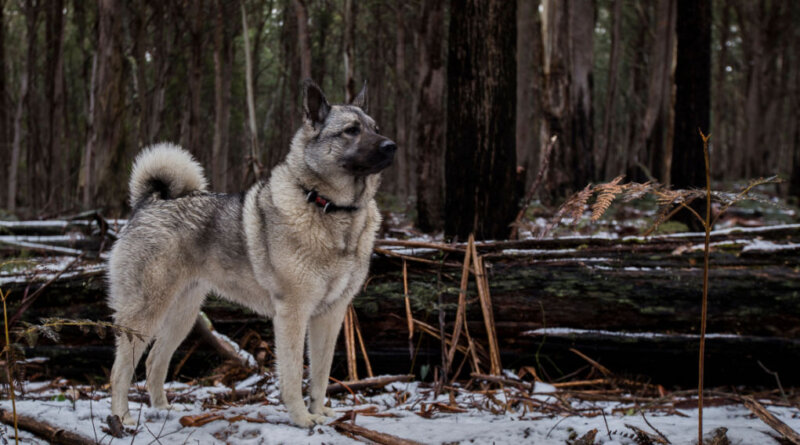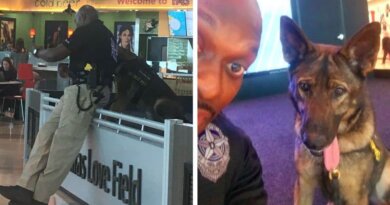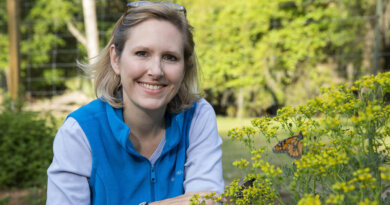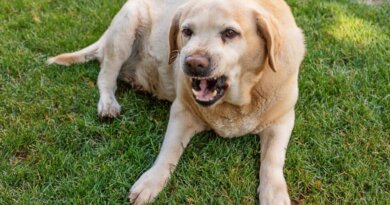Norwegian Elkhound Dog Breed Profile – Top Dog Tips
Be amazed at Norway’s national dog, the Norwegian Elkhound!
Elkhound dogs are hardworking working dogs that served alongside their Viking masters.
Their energy, stamina, and great predator instincts perfect the art of hunting and herding duties.
In this blog, we’ll discuss the dog profile for the Norwegian Elkhound breed—from its history, care, and living with them.
We’ll also talk about the Norwegian Elkhound personality and its temperament. What are their traits and how do we interact with them?
Without further ado, let’s start!
Norwegian Elkhound Breed History
Norwegian elkhounds are ancient dog breeds in the Norwegian country and one of the oldest dog breeds in the world.
You can trace the Norwegian elkhound breed from thousand years ago, even before the Viking era in 800 AD started.
In the past, Norwegian elkhounds were cunning dogs that prey even against large animals like elk.
They also show great adaptability and endurance even during a harsh climate in the Scandinavian environment.
So when the Vikings needed an all-around hardworking dog to breed, they chose Norwegian elkhound because of their resiliency.
And thus, Norwegian elkhound became an essential part of the Viking’s life.
Staying true to their roots, they became great hunting dogs for the Vikings.
They also were effective in herding dogs to the Viking’s cattle, horses, and other livestock.
As working dogs, they provided indispensable assistance to Viking farmers in remote farms.
Vikings also employed elkhounds to do sledding and hauling duties, even if they preferred skiing in the snow.
They became so ingrained in the Viking culture that they appeared in Norse sagas, myths, and even history.
Additionally, Norwegian elkhounds are great crewmates during Viking voyages and raids. These dog breeds would witness the rise of a seafaring era and eventually its fall.
Norwegian elkhounds proved to be exceptional working dogs until the Norwegian Hunters Association took an interest in the breed in 1877.
Since then, this Norwegian elkhound dog would become a major contender in dog shows, sports, and hunting games.
Norwegian Elkhound Physical Trait
Norwegian Elkhound is a handsome dog you may want to see more often. Unfortunately, you can easily interchange it with any other elkhound or spitz type.
That’s why here are the physical traits that you need to look out for in a Norwegian elkhound.
Weight and Height
A Norwegian elkhound size falls in the medium-sized dog category. It has a compact muscular build that the dog takes full advantage of in outdoor activities.
There’s a slight dissimilarity of height and weight between the genders of this elkhound.
Most Norwegian elkhound males are larger, taller, and heavier than most female elkhounds.
Male dogs of this breed can reach a height of 20 inches and a half. It should also have a typical weight of 55 pounds.
Female Norwegian elkhounds, on the other hand, will only reach a maximum height of 19.5 inches. They’ll also have a lighter body weight of 48 pounds.
Coat
Norwegian elkhounds have medium-length fur that makes up the double coat of the dog.
The double coat, on the other hand, keeps the dog fearless and unbothered even during Norway’s chilly climates.
As for the coat color, Norwegian elkhound’s undercoat is mainly colored light gray or white. In some cases, the undercoat will have a faint gray-silver accent.
These silver highlights will appear mostly on the dog’s chest and shoulder areas.
The guard hair, however, can come in a darker shade of gray or even black. These shades in the fur will be stronger in the dog’s saddle, ears, and muzzle.
Some Norwegian elkhounds, however, will have a subtle pale tan tint appearance in warmer environments.
Distinct Features
Norwegian elkhound is a spitz dog breed.
Like most spitz breeds, Norwegian elkhound has distinguishable pointy ears and pointy muzzle.
This particular elkhound dog will also have a short, curled tail that droops to the back.
All of these spitz characteristics give the Norwegian elkhound a wolf-like appearance.
It’s for the same reason why novice dog owners will mistake Norwegian elkhounds for Siberian huskies.
Norwegian elkhound also has a striking semblance with its Swedish elkhound counterpart, the Jamthund.
So the question is, how do you distinguish this Norwegian dog from these spitz breeds?
Unlike Siberian husky, Norwegian elkhounds don’t have a defining black fur coat at their back.
Norwegian elkhounds will also have shorter yet pointy ears compared to the Siberian breed.
Now, to compare both Elkhounds, Norwegian hounds have a more consistent gray-colored fur than Jamthund. Swedish Elkhounds are also taller than Norwegian hounds.
Is the Norwegian Elkhound a Husky?
Officially, the only “husky” that the American Kennel Club (AKC) recognized is the Siberian Husky.
Nowadays, however, you can now refer to a husky if it’s a spitz dog living in arctic climates.
That’s why many people are now calling Norwegian elkhounds, “Norwegian husky.”
Norwegian Elkhound Personality
Let’s talk about Norwegian Elkhound temperament and personality.
A Norwegian husky is a proud dog with overwhelming confidence. It can and will assume a leadership role if you don’t present yourself as a dominant figure to your dogs.
As for the Norwegian elkhound personality, these hounds are typically the independent breed type.
In most cases, they’ll do things as they want to. Pleasing their master isn’t exactly their top priority.
Combine the dominant trait with its independent personality, and you have a stubborn dog breed that’s difficult to train on your terms.
It won’t also help if you’re carrying out half-witted and lousy commands. This dog is intelligent enough to discern a firm command from bad ones.
RELATED: 15 MOST STUBBORN DOG BREEDS (HARD TO TRAIN)
Can Norwegian Elkhound be Aggressive?
It’s not in their Norwegian Elkhound temperament to be aggressive types of dog breed.
Elkhound dogs had built enough self-esteem to deal with threats calmly but effectively.
Because of its confidence, the dog will less likely to meet the problem with agitation and hostility. That is, unless when you severely provoke the dog.
When that happens, the dog will meet you with much force and can resort to aggressiveness.
Do take note, however, that the profuse barking of your dog doesn’t necessarily equate to aggressiveness.
Sometimes barking is their way of communicating with you.
Living with a Norwegian Elkhound
How does it feel to live with a Norwegian Elkhound?
Well, if you want to live with a Norwegian husky, you would want a cold environment for them.
These dogs have been shown to have a low tolerance to heat and will eventually suffer in places with hot climates.
A Norwegian elkhound also has high levels of energy. They need to expend this excessive energy on something—or somewhere.
You will need to constantly find ways to tire out your canine companion.
Additionally, it would help if you immerse this hunting hound breed in nature. This means taking these Norwegian hounds to the woods, trails, and even areas with rough terrains.
But even without an open space, Norwegian hounds are still fine in an apartment setup. Just make sure that the dog will still receive its daily exercise.
RELATED: 20 DOG BREEDS THAT DON’T DO WELL IN HOT WEATHER
Can Norwegian Elkhound Be Left Alone?
Norwegian Elkhounds are high-energy, curious dogs with a constant need for stimulation.
Elk hounds crave entertainment or alleviation from extreme boredom. Without proper stimulation, your dog can cause destructive behaviors towards itself and around it.
And with a Norwegian husky having high levels of stamina, their outbursts can last for a long time.
So, does that mean you can’t leave a Norwegian elkhound alone?
Not quite.
Your dog may not be able to tolerate the cramped indoor space. But if you take your dog to a controlled open area outside, your dog can enjoy its own company.
They may go outside to stick their nose on the ground, scoop some dirt, or observe their surroundings.
That is why you need to have a large space for this type of dog breed.
A front lawn or backyard with soft grass and little vegetation is a workable area for Norwegian huskies to play on.
Norwegian Elkhound Health
Overall, a Norwegian elkhound puppy can grow to become a healthy dog breed.
Norwegian elkhound dogs are known for their adaptability and endurance.
But, healthy as they are, they still need the care and love only a dog owner can bring them.
As such, below are more health information that you need to know to keep your elk hound in good shape
Lifespan
Norwegian elkhounds have a lifespan expectancy of twelve to fifteen years.
Compared to other dog breeds, Norwegian hounds have a longer lifespan than other dog breeds.
In fact, their expected lifespan is closer to toy dog breeds which tend to live the longest across all dog breeds.
Health Problems
Norwegian elkhound breed will suffer from breed-specific health diseases too.
Overall, four health diseases are common for Norwegian elk hounds.
These are Hip Dysplasia, Fanconi Syndrome, Progressive Retinal Atrophy, and Hypothyroidism.
Hip Dysplasia on Norwegian Elkhounds:
- Is a hereditary health issue that starts during the growth stage of the dog’s bones
- Is the uneven ball-and-socket growth loosens the joint
Hip dysplasia can lead to further orthopedic complications like arthritis and muscular atrophy.
Currently, Hip dysplasia has no effective cure in sight. However, therapies and medical prescriptions can help to relieve the dog’s suffering.
Progressive Retinal Atrophy (PRA) on Norwegian huskies:
- Is a blindness-inducing disease that pertains to the abnormal development of the retina’s photoreceptor cells
- Refers to the swift deterioration of the photoreceptor cells
PRAs start with acute night blindness and can develop into cataracts. A healthy supplement of Vitamin A can help delay the deterioration of the retina.
Autoimmune Thyroiditis in Norwegian Hounds:
- Is a specific type of hypothyroidism that attacks the unrecognized thyroid gland
- Impedes normal body functions due to the overlying hormonal imbalance in dogs
To regulate the hormonal imbalance, Norwegian elkhounds suffering from hypothyroidism need to have a proper diet and maintenance.
Fanconi Syndrome in Norwegian elkhound dog breed:
- Is a kidney-related disease that refers to a defect in the kidney’s tubules
- Causes poor reabsorption of nutrients, water, and electrolytes in the urine
Fanconi Syndrome in dogs will eventually develop into kidney failure.
While there’s no treatment for kidney disease, treatment for its effects includes filling the lost nutrients from the urine.
When dealing with breed-specific diseases, your local vet is your strongest ally in relieving your pet’s sufferings.
Seek their consultation for more information, best tips, treatments, and practices to combat their diseases.
Nutrition
When it comes to a Norwegian elkhound’s diet, you should focus on feeding them various foods.
Fortunately, the Norwegian elkhound breed has an amazing appetite. You’ll have no trouble feeding them foods that most dog breeds would otherwise refuse.
That being said, these elkhounds can prove to be massive overeaters. As large as a Norwegian Elkhound size can be, you need to keep an eye on its weight.
The calorie counting method helps keep the dog’s food intake in check. Otherwise, the dogs will suffer from obesity and its complications.
Serve a protein-rich diet to your pet dog to help in muscle repair and development. You can get this type of diet mainly from meat and high-quality dog foods.
Norwegian Elkhound Grooming
Maintaining the fur coat is equally important as the fur is to Norwegian elkhounds.
And so, the question is, how do you maintain the coat of this elkhound breed? How frequently do you need to groom a Norwegian elkhound?
Here are some tips about taking good care of your Norwegian husky’s fur coat.
Shedding and Blowing Coats
Prepare for a sight of furs around your house because it will rain dog fur every day.
Norwegian elkhounds are known to shed their fur a lot, which is not suited for meticulous owners.
And the most fur your dog will shed is when they blow their coats.
Double-coat dog breeds like the Norwegian hound blow their coat twice or thrice a year. They shed their undercoats in preparation for the season change.
Norwegian elk hounds usually change to their winter undercoats as the winter approaches while shedding their summer coat in the process.
Conversely, spring shedding is when they’ll shed their thick coats during the spring season.
Bath Time
Norwegian elkhounds do not necessarily need to take constant baths.
Instead, the dog relies on its guard top coats to keep itself clean.
Their top coats are harsher than the undercoat, which helps shed dirt and debris anywhere except inside their coat.
But still, Norwegian elk hounds will need a sparse amount of baths per year. Soaking your dog in a bath helps clear the dead coat to give way to new ones.
Ideally, you want to bathe your dog four times a year or before every new season start.
Brushing Fur
Norwegian elkhound’s fur will tangle, knot, and mat.
Dog fur matting is easily manageable through constant brushing of its fur. Use a slick brush to weave within its thick coat and prevents matting.
Brushing your dog’s fur scours and removes the dead furs that would otherwise shed excessively later.
Additionally, it also deals with dirt and debris that had managed to cling to the dog’s undercoat.
You should brush your dog for at least two to five minutes every day to maintain the healthy coat of your Norwegian elkhound.
RELATED: TOP 5 BEST DOG DEMATTING TOOLS
Paw Care
Your Norwegian elkhound’s paw is one of the most vulnerable parts of its body.
Their nails can break while their paws can get crusty or wounded. As such, paw care is a must for these hardworking dog breeds.
Paw care for your Norwegian elk dogs means spotting paw injuries in your dog and applying first aid treatment.
Immediately rinse the wound, apply disinfectant, and then wrap it with bandage gauze.
It would also help to trim the nails to the appropriate shortness. Lengthy nails can put painful pressure on your dog’s nail bed.
Additionally, you can apply plant moisturizers and wax to your dog’s paws. This prevents the paw from drying and eventually cracking.
RELATED: TOP 5 BEST PAW BALMS FOR DOGS
Norwegian Elkhound Exercise
When it comes to exercise, use the Norwegian Elkhound size to your advantage!
Norwegian elkhounds are energetic dogs that crave the outside environment. They are more than willing to do some exercise with their owners.
This dog breed requires short but high-intensity exercises that are manageable in under an hour or two.
A little of these intense workouts go a long way in keeping these dog breeds in shape.
Below are some exercises that a Norwegian elkhound dog would be excited about.
Agility Course
If you trained your Norwegian elkhound well, they’re better suited for an agility course as their mode of exercise.
The agility course should consist of hurdles, tunnels, weave poles, and seesaws where your dog can play around.
Your job is to command and direct your pet through the course.
You can go through the agility course with a time limit. Time constraints serve as physical and mental stimulation to your dog.
But even without the time limit, the agility course is already a strenuous activity that your agile dog will love.
Play Tag
Playing with your pet is already a common exercise activity for your dog. But you can turn it up a notch and make the activity much more stimulating.
Chase tag is a solid owner-dog bonding playtime that you should apply with your Norwegian elk hound.
Apart from physical exercise, it also stimulates its chase instincts, which are helpful for hunting activities.
Normally, playing tag with people involves an “it” to chase and tag a new person.
But when it comes to dog chase tag, it involves more than just its legs to play it.
To play tag with your pet:
- Have your dog sit at a location
- Go to another location where the dog can see you
- Command your dog to tag you
- When your dog runs towards you, give it a treat
- Add difficulty by furthering the distance until you’re finally moving away from the dog
- Add difficulty in the command until you’re running at your full speed
Swimming
Yes, Norwegian elkhounds are great swimmers too.
Swimming is an excellent exercise for you and your dog.
This is because the activity improves not only your stroking form but your cardiovascular endurance as well.
RELATED: 20 BEST SWIMMING DOG BREEDS
Norwegian Elkhound Socialization
A Norwegian elkhound is a social dog that can befriend almost anyone.
While these dogs bark at strangers during first encounters, they get easily attached shortly after. That is, of course, if you give enough time for the dog to get used to the new face.
These elk hounds need to recognize first that the new face isn’t a threat to the family, its territories, or to itself.
Norwegian huskies are also great for children and teens. They’re also fine with other dogs and creatures.
Make sure, however, that there’s enough supervision on the first few encounters with the Norwegian husky.
A Norwegian husky will assert their dominance over children or creatures when they’re given the chance. The worst is when these huskies see the children as prey.
But the true asset of Norwegian elk hounds’ social characteristics lies in their affection.
Norwegian elkhounds are extremely affectionate and loyal to their owners. They can even fight to the death, trying to protect their beloved owners from harm.
Norwegian Elkhound Training
Norwegian Elkhounds are notorious for being stubborn during training sessions. They are not suitable for unconfident owners.
While they understand basic commands and routine behavior, they’ll show resistance to other aspects of training.
They are also prone to wreak havoc around the house if left to their boredom.
Responding to the Norwegian elkhound temperament, we recommend three pieces of training to help your elkhound adapt to your lifestyle.
These are obedience training, scent training, and crate training.
Obedience Training
Norwegian Elkhound training is already a challenge for an experienced trainer. Imagine how arduous the training will be for an unassertive owner.
To deal with their stubbornness, you should resort to teaching your dogs to respect you.
Respect training employs positive yet firm reinforcements to your dog.
You give reward them for their desirable behaviors and use corrective verbal cues like “no” for inappropriate ones.
With this type of training, you are telling your dog what actions they should keep doing.
Additionally, you can teach obedience at an early age, preferably to a Norwegian elkhound puppy.
However, note that obedience training won’t be possible if you aren’t assertive and consistent.
Crate Training
Crate training is behavioral training that teaches your dog to spend time in its crate.
Crate training helps both the Norwegian elkhound dog and its owner for a lot of reasons.
In fact, it’s one of the must-have dog training for your dog in an apartment.
For one, the dog can tolerate confinement and will begin to appreciate cozy small spaces. It helps curb their desire to go outside for most of the time.
The dog will also associate the place with comfort, which is helpful when the dog suddenly becomes agitated.
Crate training also helps assert the dog’s dominance now that they have a territory to defend.
Lastly, crate training can finally help you leave the dog alone for a substantial amount of time.
Scent Training
As the name implies, scent training drills the dogs to detect odors. More than that, it trains the dog to distinguish a scent from other non-cued odors.
Scent training may seem over the top and unimportant for household dogs. But for a hunting dog like a Norwegian elkhound, scent discrimination can be extremely useful.
This training enhances this dog breed’s already exceptional tracking instincts during the hunting period.
Additionally, the training also helps awaken the dog’s predator instinct which is another useful feature during hunting seasons.
Norwegian Elkhound Roles
Norwegian Elkhound best fits the role of a hunting dog.
It’s the reason why Vikings specifically picked this breed to be their companions during hunting seasons.
Elkhounds are masters of tracking their prey. They would go after their small prey, pinning them down and barking non-stop to alert the hunters of a caught prey.
They would even hunt for prey that is larger than their Norwegian elkhound size, even moose and elks!
Norwegian elkhound also fit the role of a guard dog, watchdog, or herding dog. When these elkhounds suspect a threat or a stranger, they’ll bark profusely at their targets non-stop.
Lastly, Norwegian elkhounds are great family dogs. These proud dog breeds prefer the extreme affection of their owner through a good cuddling session.
RELATED: 14 BEST WATCH DOG AND GUARD DOG BREEDS
Are Norwegian Elkhounds Rare?
Being the national dog of the country, Norwegian elkhounds are still abundant in Norway, their place of origin.
That being said, you rarely see these types of dog breeds in America.
You can try to visit animal shelters across the country and see if a Norwegian Elkhound is waiting for an owner to adopt them.
Additionally, groups like the Norwegian Elkhound Association of America Inc. are doubling their efforts to save the dog breed.
Norwegian Elkhound: Conclusion
A skillful hunter in the woods but an affectionate canine inside your house—Norwegian Elkhounds are a great choice as a companion breed for people in the fieldwork or indoors.
Elkhounds are diligent dogs that are reliable in a lot of outside work.
They are extremely energetic dogs bred for hunting, guarding, and herding that goes way back to the Viking reign.
Indoors, Norwegian elk hounds have a great sense of belongingness. They would love to belong to a close-knit family.
As for the Norwegian Elkhound temperament, these dogs are independent and confident thinkers.
With a firm command, confident stance, and positive training, you can gain their trust, loyalty, and obedience in no time!
READ NEXT: HYGEN HOUND DOG BREED PROFILE









